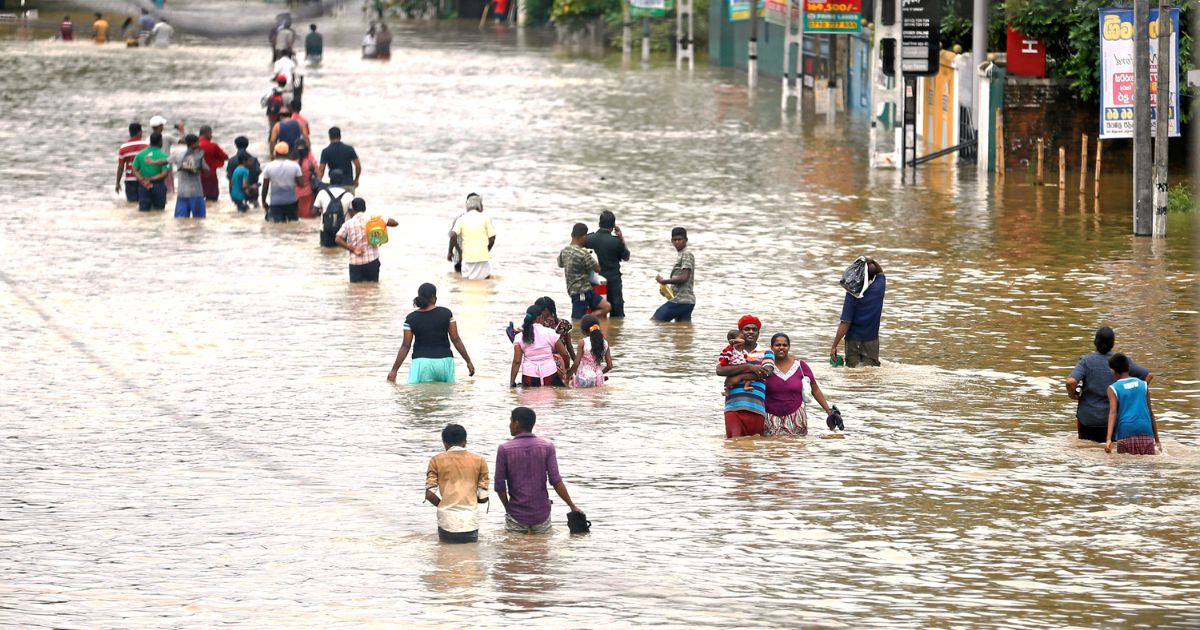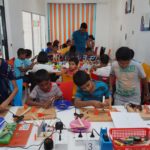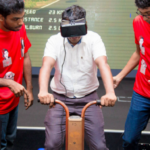The 2004 tsunami was a while ago. When December rolls around, the disaster will be exactly 12 years behind us. Those who do recall the ill-fated Boxing Day and the tragedy that followed probably also recall thinking ‘There’s no way we could have called it.’ Were the recent floods equally unpredictable? Was the country not technically equipped to have taken action when we experienced the heaviest showers in 25 years?

This UN Office for the Coordination of Humanitarian Affairs (UNOCHA) report spells out some of the stats. 203 people we learn are either dead or missing and 301,602 Sri Lankans have been affected by these floods. We’ve already reported on the tech made available to aid victims of the floods, our aim now is to find out if these stats would be different if people were given clear warnings of impending disaster. Naturally then, our first question was if Sri Lanka is equipped with tech capable of functioning as an early warning system.
Disaster and Emergency Warning Network (DEWN)
With development spearheaded by Dialog Telekom as it was known at the time, in partnership with Microimage and Dialog-University of Moratuwa Mobile Communications Research Laboratory, we learn that this is a post-tsunami initiative. CEO of Microimage Holdings Harsha Purasinghe explains that “the whole idea behind DEWN” was to get warning messages out to the public.

More importantly, he points out, this system allows warnings to be sent not only to multiple parties but to “targeted to a specific group of people” in hazardous zones. You can read more on how DEWN works here. Initially, the system was “used to warn Media Institutions” of any disasters, such as the floods so that the public was, in turn, notified, however, a re-vamping in 2014 has now made DEWN accessible to any smartphone user.
So far DEWN’s mobile application is only available for Android but the iOS version will be coming out soon we learn. As there was no Disaster Management Centre (DMC) when DEWN came into being, it was subsequently shared with the authority once inaugurated. Trials have taken place with the DMC on board since 2010.
What is the DMC Doing with DEWN?
We spoke to Assistant Directors of the Emergency Operations Centre (Early Warning) under the DMC, Ravi Jayarathna, and Pradeep Kodipili, both of whom confirmed that DEWN was functional during the turbulent rains this May that caused the floods.
Since DEWN can send SMS warnings (around 8.8 million messages to be precise) across the country, it can easily result in a jammed network. For this reason, Ravi Jayarathna explained, “We have identified 5,000 key contractors” to whom the warning is sent directly. These recipients are broken down into three levels of priority.

Level one will include all the relevant Directors and Assistant Directors of state authority with respect to disaster management. Level two consists of “first respondents” such as the District Secretaries, Forces and emergency medical units. Level three includes the general public, and “certain NGOs like the Red Cross.”
According to Pradeep Kodipili, a phone isn’t the only means of communicating the DMC’s warning. They have 25 Disaster management Units across the 25 districts. These units are equipped with vehicles packed with VHF and satellite communication methods, all of which have been deployed once they received DEWN’s warning of the recent disaster. The UNOCHA report we alluded to previously, also mentions that the Government’s strong Disaster Management infrastructure was put to action.
“People knew there was a flood warning,” he says, “There were media and SMS warnings and it was even announced through speakers” at various locations. “The issue was that people didn’t expect it.”
What Went Wrong During The Floods?
“DEWN can only specify the region” prone to disaster the two Assistant Directors tell us. Exact locations of landslides or flash floods are difficult to discern. This explains the unfortunate loss of life at the Aranayake landslide.
Yet another issue is that “people didn’t take the warnings seriously” according to Pradeep Kodipili. It wasn’t until the water rose up to 3 feet that they realized the situation was dire. “We have village evacuation committees,” built of volunteers and clearly marked evacuation routes. The DMC he says is also training citizens to spot potential disasters which “even a child can do.”
Ravi Jayarathna confirmed this. Each District Disaster Management Centre has the training, “but people are not interested” and as a result have no ability to judge a disaster. If the “15,000 deaths” resulting from Japan’s 2011 tsunami says anything he feels it is that “money and experience” count for little if you “can’t judge a disaster.”
“The DMC can’t do it alone” we’re told. Public cooperation plays a key role in ensuring their safety. But the inbuilt “normalcy bias” among people is so strong that they choose to ignore evacuation warnings. “They need to change their minds, sophisticated systems can’t do it.”
What We Saw
Last Tuesday we paid a visit to some households in Biyagama that were affected by the floods. Residents were trying to figure out where to start cleaning up in order to resume a normal life. Hint: none of them remember any announcement about floods or evacuation.
Relief fails
Pictures of half-submerged rice packets and bags of maalu-paang dumped in the trash spoke volumes of the lack of a centralized system to communicate information. In fact, the UNOCHA report also recognizes that camp coordination and camp management (CCCM) could have gone better.

Our next step was to find tech that could possibly help with smooth relief operations, and we found Sahana.
What Is Sahana?
Sahana is yet another post-tsunami endeavor engineered by Sri Lankan IT professionals. The Sahana Foundation’s website calls it an ‘open source disaster management software.’ Former Director of the Information and Communications Technology Agency (ICTA) of Sri Lanka, Wasantha Deshapriya enlightened us further as to the software’s use.
The purpose of Sahana “is post-disaster management” he tells us. Every detail from coordinating aid requirements between camps of displaced persons to the ideal location of camps can be gathered by feeding this software with adequate data.

An added advantage is the inter-camp communication this allows, which would make recording displaced people and their whereabouts much easier. “I went to see the affected people” he shares, and the issue of patchy distribution of aid was very clear “Some got more than they need, others had nothing.”
Disheartened that the software was not in use by the government when we spoke to him last week, he believes “GIS systems are the best” means of dealing with land-based issues. “Even Google was in support of Sahana,” offering 10 of its ‘Coder Summer’ interns to work on the software.
Currently used in other countries such as “during the tsunami in Japan, earthquakes in Peru, Chile, Pakistan and India” he feels we missed out on much by not making full use of the available resources. “Anyone can access it” he shares, although the Software’s current custodian is the Washington Library of Medicine.
Sri Lanka didn’t need to go far, he says “Virtusa has been working with the National Disaster Authorities from the inception” on a voluntary basis to perfect a localized version of it.
From “2010-2012” Sahana has been customized and tested by the Disaster Management Authorities we learn, and the NDRSC has its own version of the software. “It was rebuilt with an accounting package,” he says, which can even keep track of monitory support the government doles out to affected persons “sometimes, even for a year.”
What is the NDRSC doing with Sahana?
In honesty, we don’t know. All our attempts to contact the Director of the NDRSC P.H. A Wimalaweera have not been fruitful. Here’s what we do know:
- Firstly, the relief authority does know of Sahana since they’ve devoted an entire slide on their website to its success.
- Secondly, Sahana has been launched at the NDRSC according to a short article on their website.
- At the time of writing it isn’t clear if the software is in use.
So Who Saved the Day?
It’s a bird, it’s a plane, it’s social media in all its glory.
Facebook and Twitter somehow did a Transformers number and stepped in Optimus Prime style, where the Government slacked off. Our home feeds gave cat pictures and Buzzfeed quizzes a break, in their place were Crocodile memes and pictures of empty supermarket shelves. More importantly, posts related to the floods like details on provisions displaced people urgently needed and where donors could drop these goods off.

This led to an entire ecosystem of volunteers, working closely with the district secretariats to get the camps well-stocked with essentials. “Social media definitely played a starring role” according to co-founder of One World Volunteers Amalini De Syrah. “It kept constantly connecting those who had stuff with those who needed it.” In fact, she tells us “massive collection points” were made possible purely by Facebook groups
Two in particular- #FloodReliefLka- Volunteers and Flood Sri Lanka Switchboard she says were hyper-responsive. “You knew that within minutes of posting on them, you would get a reply” and this helped to centralize the communication of needs with those able to provide them. Twitter on the other had served as a means of getting quick updates.

“It was messy” she admits, “A more real-time system” would have been of better help, but the level of coordination they did manage she feels would have been impossible without these platforms.
Co-founder of community development initiative Beyond Borders, Kavindya Thennakoon feels similarly. They kept a lookout for community journalists who posted on social media, to get an idea of what the people’s immediate need was. “Whenever a request was posted,” on social media “we cross-checked” she explains, before releasing donations at their collection points.
The issue was that “there was no way of checking” if the needs posted on these volunteer groups had already been met. A centralized system of coordination is very much needed, however, she feels it shouldn’t be restricted to just the authorities, “it should be one in which everyone can get involved.”
Moral of the Story
The blame game is strong with Sri Lankans, we’ve noticed. Officials have complacently pointed fingers at civilians and chalked the unfortunate toll of the floods to their disinterest. The public, on the other hand, have no clue what the authorities are in fact doing about disasters at all, in any case conceding that whatever it is, it’s not good enough.
It is frustrating to learn that we could have been better prepared for Roanu had there been proper use of DWEN and resort to Sahana. As DMC’s own Ravi Jayarathna points out it takes a change of attitude, not only sophisticated tech to successfully tackle a disaster. We find it unfortunate that the authorities have not applied this statement with introspection since their early warning announcements have been as patchy as aid distribution.
This is also an opportunity we feel, to read up. Everyone has an opinion once it’s too late, take for example social media’s outcry on Harambe’s untimely end. If Sri Lankans managed to digitally raise funds like Dialog Axiata did, or deploy boats and air-lifts like PickMe managed along with the Forces, imagine what we could do had we known better?
Waiting for a disaster in order to inspire the question “What can I do,” makes us as complacent as those sitting on viable technology and not using it. Occasionally glancing through the government authorities’ websites and asking informed questions when the skies are sunny could be a better use of free time. Because let’s be honest, blind dependence on their expertise hasn’t worked out well for anyone.







Some details above are inaccurate re: DEWN.
I headed the DEWN project for Dialog 10 years ago, and worked with Harsha Purasinghe and the Dialog-UoM Lab team. We were working with DMC from late 2005 onwards. (not from 2010 as the article says above).
The Dialog-UoM Lab developed an alarm device that was remotely activated via an sms. This device is meant to be placed in public areas such as hospitals, markets, etc. Not sure if those devices are in operation now.
Anjual G, Could you please join this ongoing discussion, (https://www.facebook.com/chandima.gomes/posts/1530622023615115?comment_id=1531212733556044&reply_comment_id=1531998953477422¬if_t=feed_comment_reply¬if_id=1496084874216382)